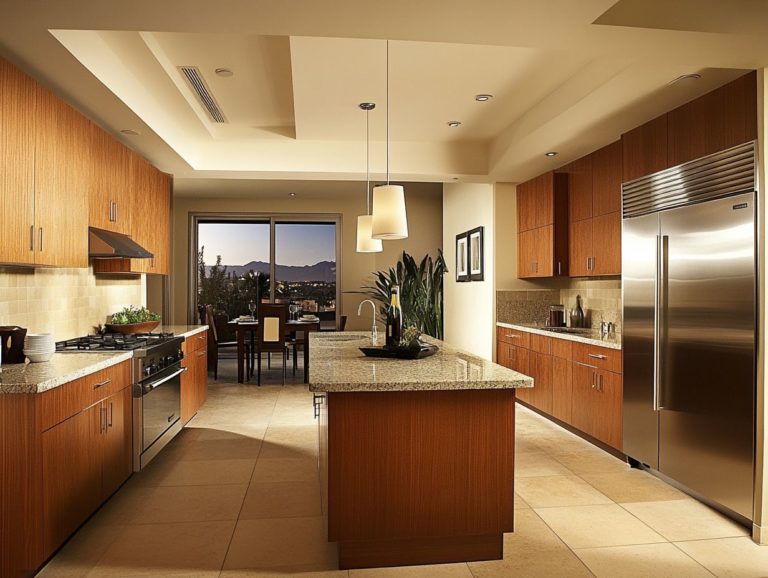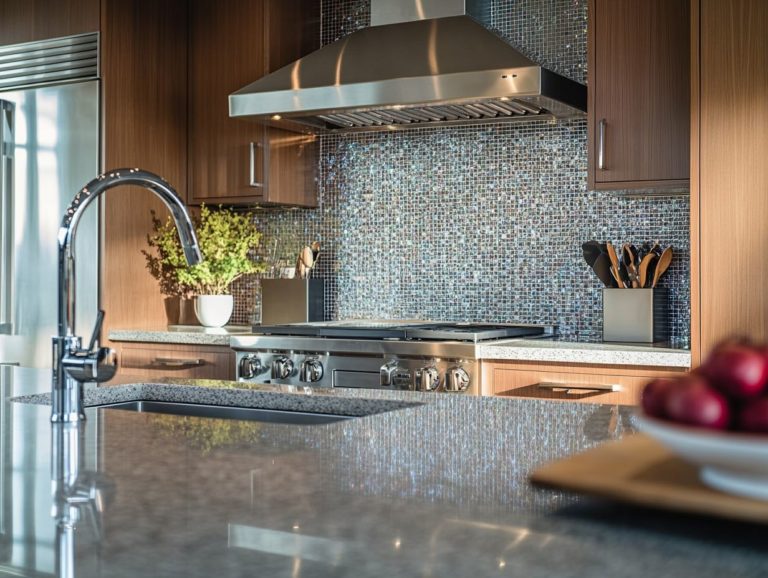Understanding the Benefits of Porcelain Tile in Kitchens
When selecting the ideal flooring for your kitchen, porcelain tile is an excellent choice.
Porcelain tile is incredibly durable and resists water and stains. This makes it both stylish and practical.
This article explores the many benefits of porcelain tile, including installation tips and potential long-term cost savings.
Whether you’re renovating or building a new space, find out how porcelain tile can transform your kitchen while staying within budget.
Contents
- Key Takeaways:
- The Advantages of Porcelain Tile
- Design Options for Porcelain Tile
- Cost Considerations
- Comparing Prices and Budgeting
- Long-term Cost Savings
- Frequently Asked Questions
- What is porcelain tile and why is it a popular choice for kitchens?
- What are the benefits of using porcelain tile in kitchens compared to other flooring options?
- How does porcelain tile hold up in high-traffic areas like kitchens?
- Is porcelain tile easy to maintain in kitchens?
- Can porcelain tile be used for kitchen countertops or backsplashes?
- Does porcelain tile come in different designs and colors for kitchens?
Key Takeaways:

Porcelain tile is a durable and long-lasting option for kitchens, making it a smart investment for homeowners. It resists water and stains, which is especially beneficial in high-traffic areas.
With a variety of colors, patterns, and textures available, porcelain tile offers endless design possibilities. It easily complements different kitchen styles, from modern to traditional.
Proper installation and regular maintenance are key to maximizing the benefits of porcelain tile. Homeowners should follow installation tips and cleaning instructions to ensure longevity.
Consider the long-term cost savings of choosing porcelain tile over other materials.
The Advantages of Porcelain Tile
More homeowners are choosing porcelain tiles to improve their flooring. They look great and last a long time.
These tiles blend stylish durability with practical elegance, making them a superb option for high-traffic areas. Their unique character and top-quality materials enhance any space’s charm while providing the resilient flooring you desire.
With porcelain tiles, you achieve a perfect balance of beauty and functionality.
Durability and Longevity
The durability and longevity of porcelain tile flooring make it an excellent choice for homeowners seeking a lasting solution. These highly-rated tiles resist scratches and wear, maintaining their beauty over time.
They withstand moisture and extreme temperatures, enhancing their versatility for both indoor and outdoor settings.
Porcelain tiles excel in high-traffic areas, where foot traffic often wears down other options. Their fade-free design guarantees that vibrant colors and intricate patterns stay intact, even in harsh sunlight.
The non-porous surface promotes superior hygiene, preventing allergens and bacteria buildup. This feature provides peace of mind for those prioritizing cleanliness.
Water and Stain Resistance
One standout feature of porcelain tiles is their exceptional resistance to water and stains, making them ideal for spaces exposed to spills and moisture.
With low porosity, these tiles minimize moisture absorption, making upkeep effortless. This quality enhances hygiene, preventing mold and mildew, common issues with more porous tiles.
Compared to ceramic tiles, porcelain holds up better in high-humidity environments like kitchens and bathrooms. Its durability makes it perfect for flooring and wall coverings, standing up to daily wear and simplifying cleaning.
A quick wipe with a damp cloth or gentle cleaner is usually all you need to keep these surfaces pristine, boosting their aesthetic and functional appeal.
Design Options for Porcelain Tile
Porcelain tile flooring offers an impressive variety of design options tailored to suit diverse tastes, making it a chic and resilient choice for different home aesthetics.
Whether you seek vibrant hues, intricate patterns, or textured surfaces, these tiles provide a captivating blend that enhances any interior space.
Color, Pattern, and Texture Choices

The extensive array of colors, patterns, and textures in porcelain tiles gives you the power to craft stunning designs that reflect your unique taste. Whether you prefer vibrant hues or subtle neutrals, the possibilities are endless.
For example, choosing MSI Aria Oro can infuse your space with a luxurious golden undertone, instantly elevating your kitchen’s atmosphere. On the other hand, Havenwood Beige adds a warm, rustic charm that beautifully complements a variety of cabinetry styles.
By pairing these tiles with contrasting elements—think sleek appliances or inviting wooden accents—you can create a dynamic and harmonious aesthetic. The range of finishes, from matte to glossy, offers even more opportunities for personalization, ensuring your kitchen resonates with distinctive character and style.
Matching with Kitchen Styles
Matching porcelain tiles with your kitchen style can truly elevate the overall aesthetic, giving you that cohesive and elegant look you desire. Whether your taste leans towards modern, rustic, or traditional, there are porcelain tiles out there that will fit seamlessly into your kitchen decor.
Imagine sleek, glossy tiles in shades like charcoal or white creating a sophisticated ambiance in a contemporary kitchen. Alternatively, textured, earthy-toned tiles can highlight the charm of a farmhouse-inspired space. If you’re after a coastal vibe, light blue or sandy beige tiles can evoke the serene essence of beach life.
Make sure to consider the existing color palette and materials in your kitchen, along with your personal tastes and lifestyle. Take time to explore various textures and finishes to find a style that truly resonates with your aesthetics, transforming your kitchen into a unique haven!
Installation and Maintenance
Proper installation and maintenance are essential for maximizing the longevity and performance of porcelain tiles. Though it does come with its own set of challenges, the benefits of porcelain tiles are worth the effort!
Whether you opt for professional installation or decide to tackle it yourself, grasping the nuances of the process will pave the way for a successful flooring upgrade.
Tips for Proper Installation
For a flawless finish when installing porcelain tile flooring, following expert tips can truly elevate your results. While professional installation is often the gold standard, preparation will be your best ally if you choose the DIY approach.
Start with meticulous surface preparation; the surface underneath your tiles must be impeccably clean, dry, and level to prevent any future headaches with uneven tiles.
Next, take a moment to carefully plan your layout. Consider the tile arrangement and cutting measurements to enhance the aesthetic appeal and minimize waste.
Choosing the right adhesive is another critical step, as it significantly influences the durability and longevity of your flooring.
By adhering to these essential guidelines, you can sidestep common pitfalls like uneven tiles or adhesive failures, ensuring a smooth and successful installation process that stands the test of time!
Cleaning and Care Instructions
Cleaning and caring for porcelain tiles is a breeze, making them the perfect choice for homeowners who value effortless upkeep. By sticking to a regular cleaning routine, you can ensure that your tiles retain their beauty and performance for years to come.
To keep your porcelain tiles looking immaculate, it’s essential to establish a cleaning schedule. Daily sweeping or vacuuming helps remove dirt and debris, preventing scratches that can dull their finish—especially in high-traffic areas like entryways and kitchens.
For a more thorough clean, a damp mop with a cleaner that doesn’t harm surfaces works wonders. Just steer clear of harsh chemicals that could damage the surface. A mixture of vinegar and water can also help sanitize the tiles, but don’t forget to rinse afterward to avoid any residue.
By incorporating these care tips, you not only enhance the aesthetic appeal of your space but also extend the lifespan of your flooring!
Cost Considerations

When contemplating a flooring upgrade, it’s crucial for you to grasp the cost implications associated with porcelain tiles. By carefully analyzing installation expenses and the price per square foot, you can make informed decisions that align with your budget.
This approach ensures you discover affordable solutions while maintaining the quality you desire. Don’t miss out on exploring your options!
Comparing Prices and Budgeting
When budgeting for your flooring project, comparing prices per square foot for porcelain tiles empowers you to make informed financial decisions. By understanding the range of available prices, you can accurately budget for your renovation.
It’s essential to look beyond the sticker price. Different suppliers offer varying qualities that can significantly affect both durability and aesthetics. Assess factors such as water resistance, how well the color lasts, and texture. These elements contribute to the longevity of your investment.
As you consider costs, remember to factor in installation expenses, which can vary widely based on location and labor. Setting a realistic budget that includes both materials and installation will help you avoid unexpected financial surprises. This ensures a smooth renovation process that aligns perfectly with your overall vision.
Long-term Cost Savings
Investing in porcelain tiles is not just a smart choice; it’s a decision that pays off immensely over time! Their durability and minimal upkeep requirements lead to significant long-term cost savings. While the initial price tag might seem steep, the longevity and low maintenance will prove to be worthwhile.
Unlike hardwood or carpets that can wear down or require regular refinishing and cleaning, porcelain tiles stand resilient against scratches, stains, and moisture. This makes them an ideal choice for high-traffic areas.
The hassle of frequent replacements or intensive cleaning is greatly minimized with porcelain tiles, resulting in lower labor and material costs over the years. Compared to vinyl or laminate flooring, which may require periodic replacements due to wear, porcelain tiles offer a long-term solution that boosts aesthetic appeal and elevates your property value.
With the right selections, this investment can lead to substantial financial benefits in the future.
Frequently Asked Questions
What is porcelain tile and why is it a popular choice for kitchens?
Porcelain tile is a type of ceramic tile made from dense and durable clay. It is highly resistant to stains, scratches, and moisture, making it an ideal choice for high-traffic areas like kitchens.
What are the benefits of using porcelain tile in kitchens compared to other flooring options?

Porcelain tile offers several benefits for kitchens, including:
- Durability
- Resistance to stains and moisture
- Easy maintenance
- A wide range of design options
It is also a cost-effective choice as it can last for decades with proper care.
How does porcelain tile hold up in high-traffic areas like kitchens?
Porcelain tile is an ideal flooring option for high-traffic areas like kitchens because it is highly durable and resistant to scratches and wear. It can withstand heavy foot traffic and is less likely to chip or crack compared to other flooring materials.
Is porcelain tile easy to maintain in kitchens?
Yes, porcelain tile is easy to maintain in kitchens. It requires minimal cleaning and can be easily wiped down with a damp mop or cloth. Its non-porous surface also makes it resistant to stains, making it practical for busy kitchens.
Can porcelain tile be used for kitchen countertops or backsplashes?
Yes, porcelain tile can be used for kitchen countertops and backsplashes. It is a versatile material that can be cut and shaped to fit any space. It is also resistant to heat, making it a safe option for kitchen countertops.
Does porcelain tile come in different designs and colors for kitchens?
Yes, porcelain tile comes in a variety of designs, colors, and patterns. It can mimic the look of natural stone, wood, or even concrete, allowing homeowners to achieve their desired aesthetic for their kitchen.
Ready to explore your options further? Contact a professional for installation today!





